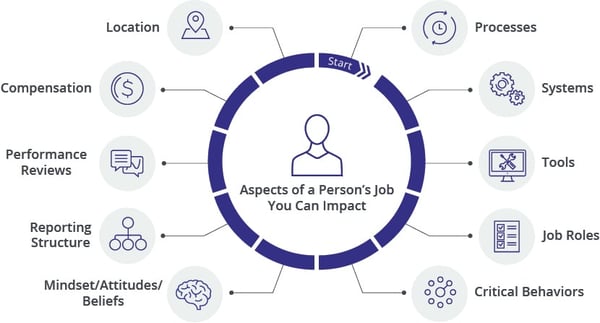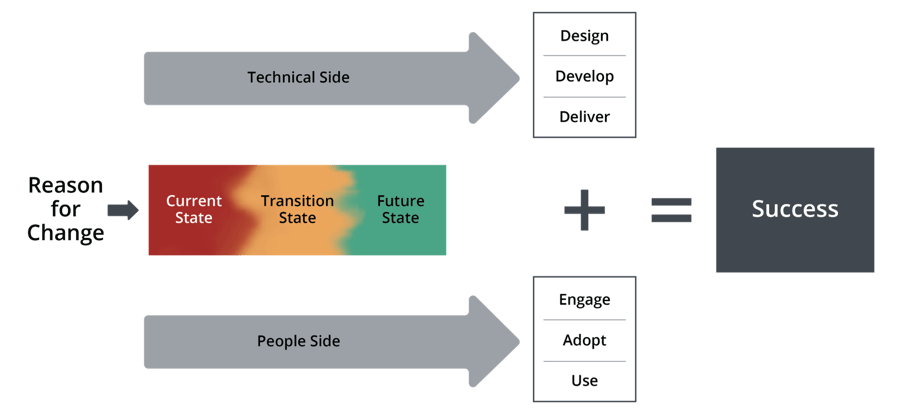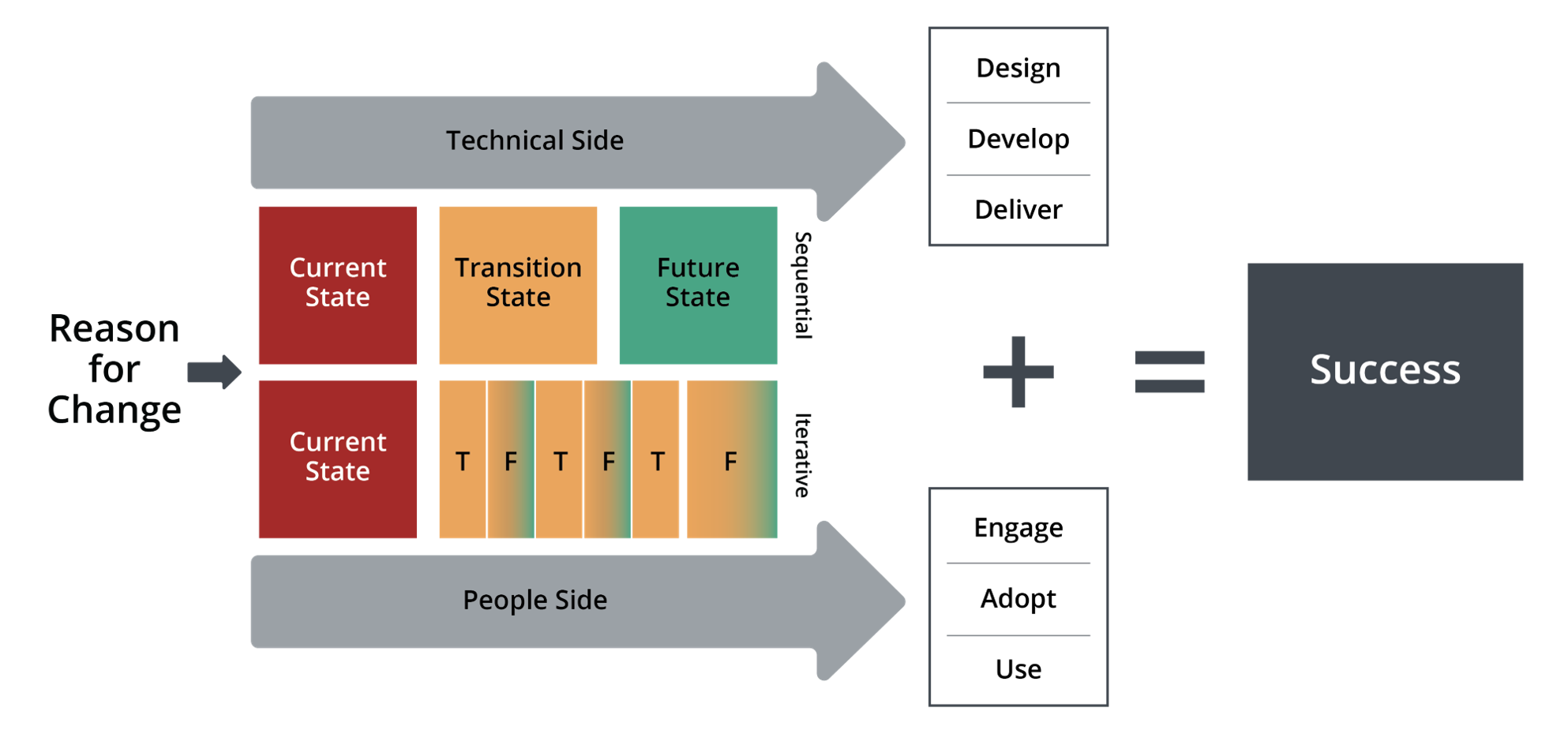Definition of Change Management

5 Mins
Updated: August 7, 2025
Published: May 18, 2022

How often do colleagues and coworkers ask you, "What is change management?" Although many of us know intuitively what change management is, we can have a hard time defining it succinctly for others.
Change Management Defined
Prosci defines change management as the application of a structured process and set of tools for leading the people side of change to achieve a desired outcome.
When defining change management for others, it's helpful to discuss it in the context of two closely related concepts: the change itself and project management.
The change itself
A change is the project, initiative or solution being introduced in the organization to improve the way work gets done, solve a problem, or take advantage of an opportunity. Nearly any project, initiative or solution that improves an organization will affect how employees do their day-to-day work. Prosci’s 10 Aspects of Change Impact depicts how a person or group may be impacted by a change:
 The idea of becoming “more competitive” or “closer to the customer” or “more efficient” can be the motivation for an organization to change, but at some point, these goals must be translated into specific impacts on these processes, systems, tools, etc. This is where project management and change management come in.
The idea of becoming “more competitive” or “closer to the customer” or “more efficient” can be the motivation for an organization to change, but at some point, these goals must be translated into specific impacts on these processes, systems, tools, etc. This is where project management and change management come in.
Project management and change management
It is not enough to merely prescribe the change and expect it to happen. Successful change starts with an understanding of what must take place to make the change happen, as well as hard work. Project management and change management are separate disciplines applied to organizational changes to improve the likelihood of success and return on investment (ROI). These distinct yet closely intertwined disciplines are necessary to bring a change to life.
Project management – the technical side of change
According to the Project Management Institute’s PMBOK® Guide, project management is the use of specific knowledge, skills, tools and techniques to deliver something of value to people.
While project management is typically associated with a traditional Waterfall approach, there are numerous ways to deliver projects. Change management can work alongside any project management methodology, such as Agile, Scrum, Kanban, Lean, Waterfall and PRINCE2.
Regardless of the approach used to design the technical solution, change management focuses on preparing, equipping and supporting individuals to adopt and use the changes.
Change management – the people side of change
Change management is the application of a structured process and set of tools for leading the people side of change to achieve a desired outcome. We apply change management by helping individuals impacted by a change make the successful personal transitions that enable them to engage, adopt and use a change.
Both project management and change management support moving an organization from a current state (how things are done today), through a transition state, and to a desired future state. Project management focuses on the tasks required to successfully design, develop and deliver the project, initiative or technical solution. Change management focuses on the people impacted by this change and enables them to engage, adopt and use the change.

For iterative projects, outcomes are achieved through repeated cycles or releases of change, with each cycle moving toward the final, intended outcome. Iterative project management is typically associated with Agile approaches to designing, developing and delivering solutions. Change management comes alongside the project management approach and focuses on preparing, equipping and supporting individuals to adopt and use the changes, regardless of whether it is delivered iteratively or sequentially.

Note that the technical side is not necessarily “technological.” Although projects are sometimes technological in nature, the technical side applies to all changes. This includes culture changes, mergers and acquisitions, policy updates, and other projects or initiatives that may or may not involve technology.
Any organizational change will have both a technical side and a people side, and each requires separate resources and tools to bring the change to fruition.
Discipline and Focus |
Example Processes |
Tools |
|
Project management (Technical side)
|
Project Management Institute's Domains:
|
|
|
Change management*(People side) Enable people to engage, adopt and use the change
|
Prosci 3-Phase Process:
|
|
Goals of Each Team
The project management team works to move the technical side of the change forward from point A to point B. Such project management activities apply to the processes, systems, tools, etc. impacted by the change, which means people’s jobs will be impacted.
The change management team works to help the individuals impacted by the change willingly support or accept the change, take on the change as one’s own, and apply the change as expected (i.e., engage, adopt and use the change).
The example below shows the transition from function (a) to function (b).
.png?width=600&name=MicrosoftTeams-image%20(12).png)
The goal of project management is to effectively deploy resources to design, develop and deliver the project, initiative or solution. The goal of change management is to help each individual impacted by the change make a successful transition, given the change's requirements.
|
Element |
Objective |
|
The change itself |
To improve the organization in some fashion, such as reducing costs, improving revenues, solving problems, seizing opportunities, aligning work and strategy, or streamlining information flow within the organization (i.e., the project, initiative or solution). |
|
Project management |
To realize project objectives and organizational benefits from successful change by designing, developing and delivering the technical solution—given time, cost and scope constraints—and to utilize resources effectively (i.e., managing the technical side of change). |
|
Change management |
To realize project objectives and organizational benefits by applying a systematic approach for helping people impacted by change move through their individual transitions, so they can successfully engage, adopt and use a solution (i.e., managing the people side of change). |
Extent of Change Management and Project Management
Nearly every organizational initiative or project requires some level of project management and change management. There are very few instances where you will not need both disciplines. Each of the projects below needs separate project management and change management, in addition to deploying the change itself:
- Deploying an Enterprise Resource Planning (ERP) solution across the entire organization
- Re-engineering the work processes and contact scripts of your call center agents
- Integrating two organizations and their information systems following a merger or acquisition
- Implementing new virtual collaboration tools for a distributed workforce
- Developing a new sales channel
Do project management and change management look the same for every initiative? Typically, no. While most need at least some, each discipline works best when customized for your unique situation, organization, culture and history, and the specific change that you are implementing.
The amount and type of project management you need depends on the complexity, degree of change, and amount of flexibility required in the solution design. The amount of change management engagement needed depends on the amount of disruption to individual peoples’ day-to-day work. It also depends on the organization’s attributes, such as culture, value system, and history with past changes.
Integrating Change Management
and Project Management
While they are distinct fields of study, change management and project management are integrated in practice. The steps and activities move in unison as teams work to progress from the current state to the desired future state.
Change management and project management planning activities
As an example, consider the activities that occur during the planning phase of a project or initiative.
Project managers:
- Identify the milestones and activities that must be completed
- Outline the resources needed and how they will work together
- Define the scope of what will and will not be part of the project
Change managers:
- Craft key messages that must be communicated
- Work with sponsors to build active and visible coalitions of senior leaders
- Make the case to impacted employees about why the change is needed
The most effective projects integrate these activities into a single project plan.
Understanding Has Benefits
It can be difficult to distinguish between the change, project management and change management. In practice, these three components are closely intertwined to deliver a positive outcome to the organization. But understanding the distinctions makes it far easier to troubleshoot when a change is not moving ahead as expected.
For instance, are the challenges coming from:
- The design of the change (the project, initiative or solution itself)?
- The technical process, activities or resources (project management)?
- How individuals are accepting or resisting the change (change management)?
When you understand the differences between the change, project management and change management, identifying corrective actions becomes clear. And when you know what each component is working to achieve, defining change management for others is no longer difficult.




